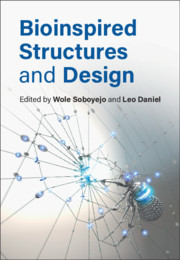Book contents
- Bioinspired Structures and Design
- Bioinspired Structures and Design
- Copyright page
- Contents
- Contributors
- Preface
- Part I Materials
- Part II Structures
- 5 Bioinspired Underwater Propulsors
- 6 Bioinspired Design of Dental Functionally Graded Multilayer Structures
- 7 Bionic Organs
- 8 Bioinspired Design for Energy Storage Devices
- 9 Bioinspired Design of Nanostructures
- Part III Natural Phenomena
- Index
- References
9 - Bioinspired Design of Nanostructures
Inspiration from Viruses for Disease Detection and Treatment
from Part II - Structures
Published online by Cambridge University Press: 28 August 2020
- Bioinspired Structures and Design
- Bioinspired Structures and Design
- Copyright page
- Contents
- Contributors
- Preface
- Part I Materials
- Part II Structures
- 5 Bioinspired Underwater Propulsors
- 6 Bioinspired Design of Dental Functionally Graded Multilayer Structures
- 7 Bionic Organs
- 8 Bioinspired Design for Energy Storage Devices
- 9 Bioinspired Design of Nanostructures
- Part III Natural Phenomena
- Index
- References
Summary
A growing number of developments in biology and materials chemistry highlight the notion of bioinspiration – in which biological concepts, mechanisms, functions, and design are the starting points toward new synthetic materials and devices with advanced structures and functions [1]. There is no doubt that emerging and reemerging infectious diseases caused and transmitted by viruses have significantly impacted human health worldwide [2,3]. Clearly, the virus exhibits elegant architectures that could occasionally be cellular macromolecules with structures that are beautifully adapted to the functions of the virion [4]. Virus particles exist in many sizes and shapes, and they vary considerably in the number and nature of the molecules from which they are built. Most viruses show a characteristic size, in the range of tens to hundreds of nanometers [5]. Viruses are intracellular parasites that enter a host cell/body to deliver their genetic material to initiate infection. Usually, the first step in the life cycle of a virus is the attachment to host cells/bodies. These may include their abilities to interact with lipids, proteins, and sugar moieties on the surface of cells and tissue [6].
- Type
- Chapter
- Information
- Bioinspired Structures and Design , pp. 212 - 232Publisher: Cambridge University PressPrint publication year: 2020



